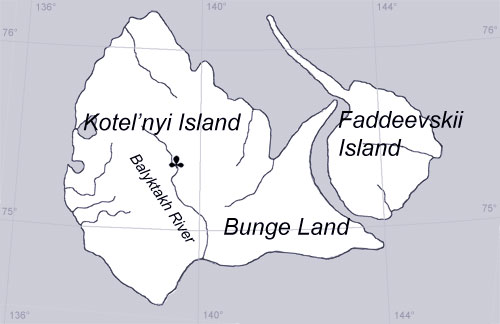Kotel'nyi Island
| Introduction | Novaya Sibir' | Kotyl'nyi | NE Russia Map | Fossil Images |
|---|
Plant fossils are abundant along the middle reaches of the Balyktakh River (75°26′46.7′′ N, 139°05′25.1′′ E) on Kotel'nyi Island. The plant-bearing beds belong to the Lower Subformation (250 m thick) of the Balyktakh Formation represented by fluvial, lacustrine and coal-bearing deposits: conglomerates, sands, sandstones, silts, siltstones, coaly siltstones and coals (up to 25 m thick). Plant fossils have been recovered at three localities: 412, 413, and 513 (see section to the right and map below). The Balyktakh Flora consists of ferns, bennettites, cycadophytes, ginkgoaleans, czekanowskialeans, conifers and gymnosperms incertae sedis (Nathorst, 1907; Vassilevskaya, 1957, 1975, 1977; Nepomiluev et al., 1979; Efremova et al., 1987; Kuzmichev et al., 2009). Overall it comprises 40 species belonging to 27 genera. Taxa identified in the collection studied by A.B. Herman are marked by asterisks (*). Polypodiopsida: Asplenium dicksonianum Heer*, Asplenium rigidum Vassilevskaya, Arctopteris cf. kolymensis Samylina*,Arctopteris sp., Coniopteris cf. nympharum (Heer) Vachrameev, Coniopteris saportana (Heer) Vachrameev*, Cladophlebis sp. 1, Cladophlebis (?) sp., Lobifolia sp., Sphenopteris sp. cf. Coniopteris compressa Vassilevskaya*, Sphenopteris sp. Ginkgoales: Ginkgoites ex gr. sibirica (Heer) Seward, Ginkgoites volnovii Vassilevskaya*, Sphenobaiera flabellata Vassilevskaya, Sphenobaiera longifolia (Pom.) Florin*, Karkenia sp.* Leptostrobales: Phoenicopsis ex gr. angustifolia Heer, Phoenicopsis ex gr. speciosa Heer ?, Czekanowskia ex gr. rigida Heer*, Ixostrobus laxus Vassilevskaya, Leptostrobus sp. Cycadales: Ctenis (?) sp. Bennettitales: Anomozamites arcticus Vassilevskaya Pinales: Brachyphyllum (?) sp., Podozamites ex gr. eichwaldii Schimper, Podozamites latifolius (Schenk) Heer, Elatocladus aff. manchurica (Yok.) Yabe, Florinia borealis Sveshnikova et Budantsev (?), Pityophyllum arcticum Vassilevskaya*, Pityophyllum ex gr. nordenskioldii (Heer) Nathorst*, Pityophyllum ex gr. staratschinii (Heer) Nathorst*, Pityostrobus sp. 1, Pityolepis tollii Nathorst*, Pityospermum sp. 1. Pinophyta incertae sedis: Desmiophyllum rigidum Vassilevskaya*, Desmiophyllum sp. 1, Alatispermum malandinii Vassilevskaya, Carpolithes sp. 1, Carpolithes sp. 2, Stenorachis sp. In the Balyktakh Flora, sterile foliage of Sphenopteris is the most abundant amongst the ferns with Coniopteris saportana occurring frequently as both sterile and fertile leaves. Arctopteris leaves, also both sterile and fertile are less abundant. The ginkgoalean Sphenobaiera is represented by numerous leaves associated with Karkenia, a lax seed bearing reproductive structure that also occurs with a foliage form that is possibly Ginkgoites. Rare Phoenicopsis and probably Czekanowskia are associated with locally abundant small and narrow Pityophyllum leaves belonging to the conifers. Other conifers are relatively rare in the Balyktakh Flora. Nathorst (1907) assigned this flora to the Jurassic. However, Vassilevskaya (1957, 1975, 1977), Nepomiluev et al. (1979) and Efremova et al. (1987), who studied much more numerous and diverse specimens from the Balyktakh Flora, considered it to be of Aptian – early Albian or early Albian age. Samylina (1976) agreed with this age determination. New finds of plant fossils and a comparison of the Balyktakh Flora with other fossil floras known in the Arctic regions also allow us to conclude that it is Aptian – Albian or most probably Albian in age (Kuzmichev et al., 2009). In terms of its systematic floral composition, the Balyktakh Flora is similar to the Albian (excluding the latest Albian) Buor-kemuss Flora that is widespread in North-eastern Asia (Samylina, 1964, 1967, 1976) and to the Kukpowruk Flora of the same age known in the western North Slope, Alaska (Smiley, 1969; Spicer and Herman, 2001). The Albian age of the Balyktakh Flora is supported by K/Ar dating (Kuzmichev et al., 2009). A study of four ignimbrite samples from the Upper Balyktakh Subformation and overlying Tuguttakh Member gave similar ages: 110 – 107 (±2.5) Ma (early – middle Albian). However, palynological data (Alexandrova and Herman, 2007; Kuzmichev et al., 2009) indicate that the flora could be as old as late Neocomian. This apparent age disparity may be due to reworking of some palynomorphs but this remains to be properly investigated. |
 |
|
Map of Kotel'nyi Island showing the position of the plant fossil locality.
|
||
Sedimentary log of the Cretaceous plant fossil-bearing sediments on Kotel'nyi Island, Russian Arctic. Bed numbers cross-reference to the map blelow.
|
||
 |
||
| Geological map of plant fossil-bearing sediments of the Balyktakh Formation (Cretaceous) and underlying Upper Triassic - Lower Jurassic units. Bed numbers cross-reference to the sedimentary log above. | ||

